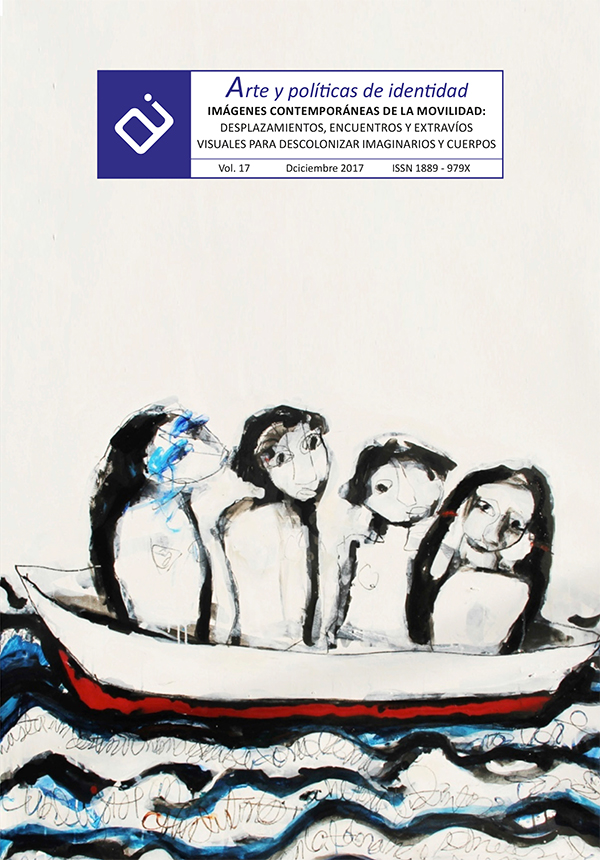Fictional migration and identities in Conchita Jurado’s proto-performances (Mexico City, 1926-1931)
Abstract
This article considers the socio-cultural meaning of the balmoreadas, a kind of heavy jokes that arise as a creative response to the privileged migration of Spaniards to postrevolutionary Mexico and whose victims were a wide range of persons. The text also reflects critically on the mutual construction of identities, these of Concepcion Jurado, a common woman of her time and the one of the fictional person she played in the completion of the balmoreadas, a rich Spanish immigrant Don Carlos Balmori who ended up eclipsing her. Finally, the article emphasizes the importance of balmoreadas as precursors of the art of action or performance art.Downloads
-
Abstract527
-
PDF (Español (España))567
References
Alcázar, J. (2008). Mujeres, cuerpo y performance en América Latina. Estudios sobre sexualidades en América Latina (pp. 331-350). Kathya Araujo y Mercedes Prieto (Ed.). Quito: FLACSO - Sede Ecuador.
Alcázar, J. (2014). Performance: Un arte del yo. Autobiografía, cuerpo e identidad. México D.F.: Siglo XXI Editores.
Alcázar, J. y Fuentes, F. (2005). Performance y arte-acción en América Latina. México D. F.: CITRU / Ex Teresa / Ediciones sin nombre.
Besacier, H. (1993). Reflexiones sobre el fenómeno de la performance. Estudios sobre performance (pp. 119-136). Sevilla: Junta de Andalucía.
Bustamante, M. (2008). Conditions, Roads and Genealogies of Mexican Conceptualism, 1921-1993. Cullen, D. (ed.) Arte≠Vida. Actions by artists of the Americas 1960-2000. (pp.134-162) New York: El Museo del Barrio.
Butler, J. (1998). Actos performativos y construcción de género: un ensayo sobre fenomenología y teoría feminista. Debate feminista, año 9, vol.18, 296-314.
Cervantes Morales, L., (1969). Memorias de don Carlos Balmori. Escritas por su secretario particular. México: Costa Amic Editor.
Cano, G. (2012). Noches púrpuras, Nexos año 35, vol. XXXIV, no. 409, 68-71.
Delhumeau, E. (1938). «Don Carlos Balmori» (su extraordinaria vida y hazañas). México: Omega.
Gabara, E. (2008). Errant Modernism. The Ethos of Photography in Mexico and Brasil. Durham and London: Duke University Press.
Goldberg, R. (1979). Performance. Live Art 1909 to the Present. New York: Harry N. Abrams.
Guzmán, A. y Díaz Cruz, R. (2015). Antropología y performance: algunas intersecciones y rutas de investigación. Diario de campo. Estudios del performance: quiebres e itinerarios. No. 6-7, 15-21.
Lebel, J.-J. (1967). El happening. Buenos Aires: Ediciones Nueva Visión.
López Zepeda, J. (2014). Don Carlos Balmori. El genio forjador de ilusiones. Bloomington: Pelibrio LLC.
Martí, F. (1981). El increíble Carlos Balmori. México: Universo México.
Pérez Acevedo, M. (2001). La presencia española en México, 1821-1930. Un recuento historiográfico. Migraciones y exilios, no. 2, 133-156.
Prieto Stambaugh, A. y Toriz Proenza, M. (2015). Performance: entre el teatro y la antropología, Diario de campo. Estudios del performance: quiebres e itinerarios. No. 6-7, 22-31.
Rodríguez-Fariñas, M. J., Romero-Valiente, J. M., Hidalgo_Capitán, A. L. (2016). Los exiliados económicos. La nueva emigración española a México (2008-2014). Scripta nova. Revista electrónica de geografía y ciencias sociales Vol. 20, 1-29.
Starr-Hunt, J. (24 de enero de 1932). The Funniest Multi-Millionaire. Modesto News-Herald. Modesto-California, 36.
Entrevista a Andrea Ferreyra, artista plástico, realizada en las instalaciones de La Esmeralda, Escuela Nacional de Pintura, Escultura y Grabado, 29 de enero de 2016:https://www.youtube.com/watch?v=83wvavPuNF4Consultado 10 de octubre de 2017.
Works published in this journal are subject to the following terms:
- The Service of Publications from the University of Murcia (publishing house) keeps the published works’ copyrights, and favors and allows the reuse of these works under the license indicated in point 2.
- Works are published in the journal’s online edition under the license Creative Commons Reconocimiento-NoComercial-SinObraDerivada 3.0 España(texto legal). They can be copied, used, disseminated, transmitted and publicly exhibited, as long as: i) the author and original source of publication are cited (journal, publishing house and work’s URL); ii) they are not used for commercial purposes; iii) the existence and specifications of this license are mentioned.
3. Conditions for auto-file. It is allowed and encouraged that authors share electronically their pre-print version (the pre-reviewed version) and /or post-print version (the reviewed and accepted version) of their Works before the publication, since it promotes its circulation and dissemination. RoMEO color: green.










